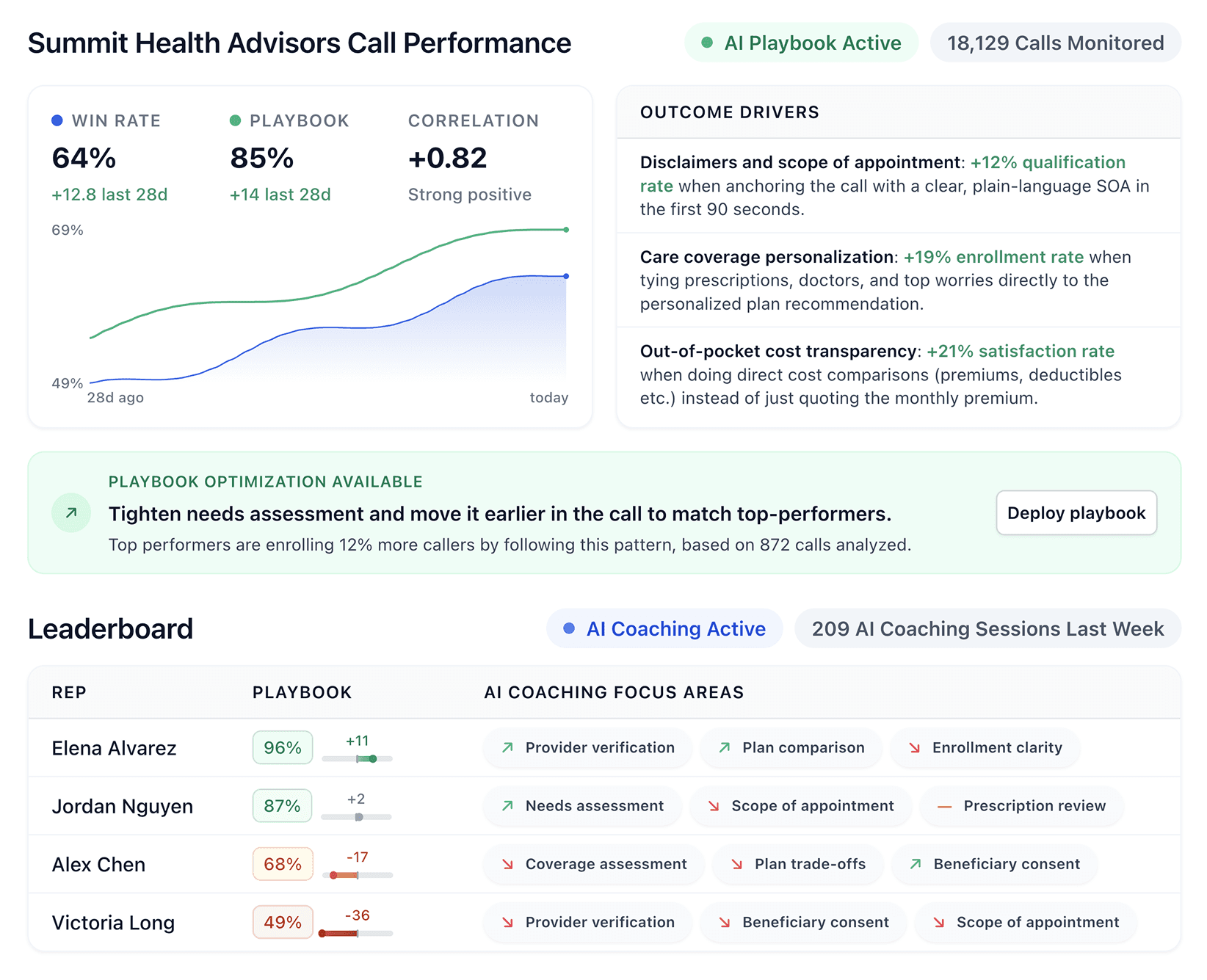Written by
Alpharun Team
Reviewed by
Alpharun Team
Published on
Oct 27, 2025
Every conversation with a prospect is a revenue opportunity, but how should sales teams use them?
Prospects judge you by how fast you respond, how personal the interaction feels, and whether your team can close. A reliable contact center system helps you turn more conversations into closed deals every time.
This guide explains the basics of call center performance management for sales teams. You'll learn what it is, why it matters, which key performance indicators (KPI) to track, and which practices to use today to improve conversion rates and pipeline velocity.
12 best practices for contact center performance management
Contact center performance starts with knowing your baseline, then improving from there.
Here are 12 ways to strengthen contact center performance management:
1. Codify your best playbook
Your top sales reps already know what works. They ask the right questions, use words that build trust, and close with lines that secure commitments and move deals forward.
Don't let that expertise stay siloed. Alpharun builds your playbook by analyzing 100-500 calls. It finds patterns that drive conversions. It surfaces the specific talk tracks and sequences your top performers use to increase win rates. Then it makes those strategies available to your entire team.
Update your playbook based on what actually works in real calls, not what sounds good in theory.
2. Evaluate every interaction
You can't manage what you can't see. Spot-checking only a small fraction of calls hides the real story of how prospects experience your sales process.
Modern quality assurance (QA) systems like Alpharun apply AI QA across 100% of conversations. You catch patterns that random sampling misses when you evaluate every call.
You see where reps excel, where they struggle, and which coaching topics to prioritize before low conversion rates become pipeline problems.
3. Coach with precision
"Be friendlier" isn't coaching. It's vague advice that leaves reps wondering what to do differently.
Real coaching points to the exact sentence that went wrong. Show your reps the specific phrase that lost the prospect's interest or the moment they missed a buying signal. Give them the exact words to use instead.
Reps actually improve instead of nodding and repeating the same mistakes when feedback is this clear.
4. Use workforce management tools
Staffing is one of the hardest levers to get right. Too few agents and qualified leads sit in queue. Too many and you're burning money on idle time.
Without workforce management (WFM), you're guessing. Modern tools predict call volume and build schedules that adjust in real time. You meet service level agreements (SLA) without burning out your team or overstaffing during slow periods.
Good WFM software pays for itself by matching staffing to actual demand instead of hope.
5. Make QA an ongoing process
Quarterly reviews are too slow. The rep has likely lost hundreds of potential conversions by the time you spot a problem and correct it.
Continuous QA uses weekly check-ins and small goals to drive steady progress. Tools like Alpharun track every interaction as it happens. Reps see their scores immediately. Managers coach based on this week's calls, not last quarter's recordings.
This turns QA from a periodic event into a daily habit that actually improves performance.
6. Give agents full customer context
Nothing kills a sale faster than asking, "Can you repeat that for me?" when the prospect already explained everything to the last rep.
With a 360° profile, agents see purchase history, past conversations, and lead stage on one screen. They know the customer downloaded Whitepaper X last month and engaged with two previous outreach attempts.
This context turns a cold call into a personal conversation. Prospects feel heard. Agents close faster.
7. Close the loop on customer feedback
Most teams collect surveys and then do nothing with them. That's wasted insight.
Instead, tag each response and map it to steps in your playbook. Do prospects consistently mention pricing concerns? Then prioritize training on value-based selling.
Do they praise specific agents? Then figure out what those agents do differently.
Tools like Alpharun link feedback directly to playbook steps. Your coaching matches what drives conversions and increases average deal size instead of what managers think matters.
8. Focus on the right KPIs
A dashboard full of metrics only creates noise. Narrow your focus to the six that matter:
Service level
Average Handle Time (AHT)
Conversion Rate
Win Rate
Revenue Per Call (RPC)
Managers and agents review them weekly to tie coaching directly to performance.
9. Actively prevent burnout
Your agents aren't machines. They can't take back-to-back difficult calls for eight hours and maintain quality.
Rotate assignments so reps aren't stuck on the same lead type all day. Mix senior and junior agents on each shift. Build buffer time between calls so agents can breathe.
Celebrate wins to show that effort matters. Burned-out agents quit or deliver terrible performance.
10. Route with intelligence
Smart routing matches prospect needs with agent skills instead of just grabbing whoever's available.
Route warm inbound leads to your closers. Send cold outbound calls to reps trained in qualification. Use language preferences to connect prospects with agents who speak their language fluently.
This saves time, improves conversion rates, and gives agents the satisfaction of handling leads they're equipped to close.
11. Deliver an easy omnichannel experience
Customers don't think in channels. They just want to buy. If they start in chat and switch to phone, the agent should see the full history immediately.
Alpharun works with contact center as a service (CCaaS) tools like Five9 and Genesys to pull all conversations together across email, chat, phone, and social media. One interface shows the complete customer journey.
The Alpharun platform also introduces AI agents for repetitive tasks like meeting scheduling and after-hours lead qualification. Your human team focuses on closing deals. AI handles routine playbook work that doesn't need a human.
12. Build a culture of collaboration
The strongest contact centers build a culture of learning. Agents share tactics. Supervisors encourage peer coaching. Team rituals like huddles and knowledge swaps sustain sharp performance and high energy.
Shared playbooks and clear insights from Alpharun make managing a call center team easier. Collaboration becomes part of the daily workflow.
What is contact center performance management?
Contact center performance management is a system that lets you plan, measure, and improve what your agents and teams actually do. It uses KPIs, feedback, and technology to raise efficiency and conversion rates.
Many teams limit performance management to handling times or QA forms. Real performance management makes teams effective on every channel and with every lead.
Contact center performance management includes:
Staffing & training to maintain sharp, quota-hitting teams
Performance monitoring with KPIs that go beyond vanity metrics
Technology integration with modern contact center management solutions
Process improvement to eliminate bottlenecks and wasted effort
Compliance & QA to protect data and maintain trust
Resource management so staffing meets real demand
Good performance management makes a call center steady. It makes the team predictable, easy to scale, and ready to convert leads.
Key metrics to track for stronger contact center management
KPIs are simple to measure but powerful when tied to coaching and performance. The contact center metrics worth tracking are:
KPI | What it means | Why it matters |
|---|---|---|
Service Level | % of calls answered within a set time (e.g., 80% in 20 seconds) | Core measure of responsiveness and queue management. |
Average Handling Time | Total talk time + hold time + after-call work ÷ calls handled | Balances thorough discovery with sales efficiency. Too high means fewer calls per day; too low means missed buying signals and rushed pitches. |
Conversion Rate | % of calls that result in a sale, enrollment, or commitment | Shows how effectively your team turns conversations into revenue. The most direct measure of sales execution quality. |
Win Rate | Closed deals ÷ total qualified opportunities | Reveals how well reps close deals once a prospect is qualified. Separates top closers from average performers. |
Revenue Per Call | Total revenue ÷ calls handled | Direct measure of sales productivity and deal size effectiveness. |
Tracking KPIs is only the first step. You need contact center performance management software to act on them. The right tool turns metrics into coaching, improvement, and consistent results.
The ideal scenario: How a high-performing contact center works
Contact centers work best when they balance the workload effectively between their people with effective processes and technology.
Agents bring the human element. Processes make sure things stay consistent and compliant. Technology gives you the tools to manage thousands of interactions without losing quality.
Here’s how each piece fits into a scalable, high-quality contact center:
People
Agents give prospects their first impression. They qualify leads, handle objections, and close deals. They also follow clear steps that ensure consistent sales execution.
Team leaders and supervisors guide them, coach them, and set schedules that maintain sales coverage.
Process
Strong processes provide the structure agents need to succeed. SLAs define how quickly a prospect should expect a response.
Escalation paths send complex deals to senior closers. Playbooks set clear steps for the team, so every lead gets the same professional experience no matter who answers the call or chat.
Technology
The last piece of a high-performing contact center is technology. It ties people and processes together. High-performing contact center solutions do two things well:
They create operational efficiency by bringing everything into one system. Centralize lead data into one place, route each interaction to the right queue, and save the full history of every prospect conversation. This context helps your agents respond quickly and accurately.
They give leaders visibility and the ability to optimize their operations. Top-performing contact centers use reports, live dashboards, and compliance checks to review their agents' every interaction with prospects. These tools also help predict demand and spot areas for improvement.
These systems align daily work with revenue targets. They give managers and agents the tools to deliver consistent experiences at scale.
Contact center roles and responsibilities
Running a contact center requires coordination across leadership, oversight, and customer-facing staff.
Here’s how the staff in a contact center divides their responsibilities:
Role | Responsibilities |
|---|---|
Contact Center Managers | Set KPIs, oversee training, and drive process improvements across the operation. |
Supervisors | Manage day-to-day activities, handle escalations, review performance, and maintain team alignment. |
Agents | Agents talk with prospects, handle objections, and close deals. They balance empathy with efficiency in every interaction. |
Alpharun’s role in modern contact center performance management
Dashboards alone will not improve team performance. Alpharun listens to every call. It learns what top reps do differently and turns those insights into a live playbook for everyone else.
Alpharun scores every conversation, delivers coaching tips down to the exact sentence, and shows managers which reps need help. Buyer behavior shifts constantly, so Alpharun adapts in real time. It helps new hires ramp faster and turns average reps into consistent performers.
Here's what else you get with Alpharun:
Data that stays private and protected, meeting both System and Organization Controls 2 (SOC 2) and General Data Protection Regulation (GDPR) standards.
Coaching that lands by pointing to the exact words or moments that need adjustment.
Dashboards managers actually use, with clear rollups by rep and team.
Performance that builds over time, raising the floor and cutting ramp times.
AI agents that handle scheduling and after-hours qualification, freeing your human team to focus on closing deals.
See how your best call becomes everyone’s baseline. Demo Alpharun today to improve your sales team and boost high-volume hiring.



